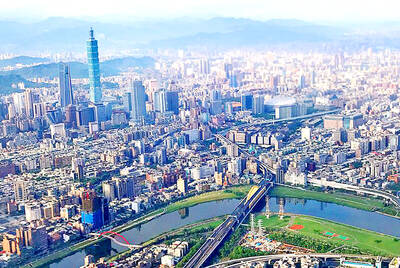Pratas Island (Dongsha Island, 東沙島) should remain closed to tourists to protect its ecosystem, said university students who visited the biggest island in the Pratas chain last month.
The island is only populated by a Coast Guard Administration (CGA) garrison, other military personnel and some occasional researchers.
People who want to visit the island must apply to the CGA, although the agency hosts short summer camp sessions for undergraduate and graduate students in collaboration with the ministries of education and the interior, the Fisheries Agency and the Marine National Park Headquarters.

Photo: CNA
Pratas is 450km from Taiwan proper, and while there is an airport on the island, private airlines only make one-and-a-half-hour trip once a week, so the CGA deployed the 3,000-tonne Kaohsiung (CG-129) to transport the camp’s attendees, a trip that can take between 15 and 19 hours one way.
The camp lasted three days, and participants learned about the island’s ecosystem from the park staff and were given a boat tour by CGA personnel.
They also took part in snorkeling, tree-planting, beach clean-ups and stargazing activities.
During their short visits, the students found that the island’s water, electricity and other basic necessities were in short supply, which makes the idea of opening the island to the public impractical, they said.
Water comes from a desalination plant on the island, but saltwater has intruded into its well, leaving the tap water salty, so potable water must be transported to the island, they said.
A diesel generator provides electricity, but the power went out in the middle of the night because of the burden of having 30 additional people on the island, they said.
Cellphone service is provided by just one carrier, with 3G and 4G, but the 4G signal is weak, they added.
There is a shortage of resources on the island, said Kuo Chin-yu (郭晉佑), a senior student studying industrial engineering and management at the National Yunlin University of Science and Technology.
The island should not be opened for tourism because as soon as people step on the island, they damage it, the students said.
However, student groups or people involved in environmental conservation should be allowed to visit, they said.
Chang Chien-chun (張建軍), a doctoral candidate in National Central University’s chemistry department, said he is vehemently opposed to opening the island to the public, as there is not enough park staff or infrastructure to support such a move.
Although the island is a national park, resources are limited, said Chen Chung-ling (陳璋玲), a professor in National Cheng Kung University’s hydraulic and ocean engineering department.
The government should prioritize protecting the island’s habitat, she said.
The Dongsha Atoll National Park was established in 2007 and is not open for tourism, but the law requires a comprehensive assessment of the park once every five years, the Marine National Park Headquarters said, adding that the park could be open for tourism if plans change.
An assessment was done in 2012, and another is scheduled for this year, it said, so from mid-June to the middle of last month it asked the public for their opinion.
Experts are to discuss whether to open the island to the public in the future, the park headquarters added.

Taipei has once again made it to the top 100 in Oxford Economics’ Global Cities Index 2025 report, moving up five places from last year to 60. The annual index, which was published last month, evaluated 1,000 of the most populated metropolises based on five indices — economics, human capital, quality of life, environment and governance. New York maintained its top spot this year, placing first in the economics index thanks to the strength of its vibrant financial industry and economic stability. Taipei ranked 263rd in economics, 44th in human capital, 15th in quality of life, 284th for environment and 75th in governance,

The Sports Administration yesterday demanded an apology from the national table tennis association for barring 17-year-old Yeh Yi-tian (葉伊恬) from competing in the upcoming World Table Tennis (WTT) United States Smash tournament in Las Vegas this July. The sports agency said in a statement that the Chinese Taipei Table Tennis Association (CTTTA) must explain to the public why it withdrew Yeh from the WTT tournament in Las Vegas. The sports agency said it contacted the association to express its disapproval of the decision-making process after receiving a complaint from Yeh’s coach, Chuang

Control Yuan Secretary-General Lee Chun-yi (李俊俋) tendered his resignation last night, admitting that he had misused a government vehicle, as reported by media. His resignation was immediately accepted by the Control Yuan. In a statement explaining why he had resigned, Lee apologized for using a Control Yuan vehicle to transport his dog to a pet grooming salon on May 20. The issue first came to light late last month, when TVBS News reported that Lee had instructed his driver to take the dog to the salon. The news channel broadcast photos that it said were taken by an unnamed whistle-blower, which purportedly showed the

Democratic Progressive Party caucus chief executive Rosalia Wu, front, grabs the pennant in a dragon boat race hosted by Qu Yuan Temple in the Shuanghsi River in Taipei’s Beitou District yesterday.